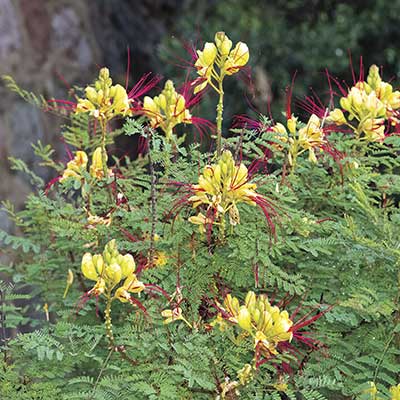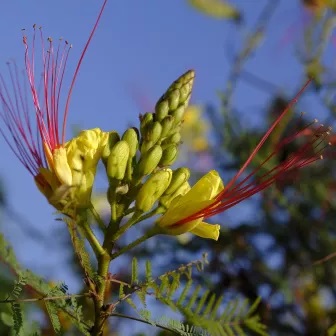Desert Bird of Paradise

Botanical Name: Caesalpinia gilliesii
Category: shrub
Divisible: No
Common Name: Desert/Yellow Bird of Paradise
Evergreen: No
Propagation: Cutting, seed
Family: Legume
Invasive: No
Size: can reach 10′
The Desert Bird of Paradise is classified as a shrub but can actually look more like a small tree. Although a non-native plant it is well-adapted to the high desert. Soft, lacy, fernlike foliage provides the back-drop for exotic yellow flowers with long, protruding red “feathery” stamens that bloom repeatedly for most of spring through fall.
Extremely drought tolerant it is deciduous and can look totally dead during the winter. Once temperatures warm it comse back to life and grows vigorously. It is high-heat tolerant and it attracts butterflies, bees and hummingbirds.



My Experience:
I don’t like to do a lot of trimming of trees – in my opinion natural shapes are best. However, the Desert Bird of Paradise is definitely prettiest when pruned out as a very small , multi-trunk tree. If left alone it can become a messy shrub or a leggy tree.
Pruning is best done in the spring while removing winter damaged branches.
Desert Bird of Paradise will sometimes self sow. You may find a new one popping up in the spring!
Growing Desert Bird of Paradise from Seed
When blooms have faded protect the seed pods by covering with a baggie or organza bag. The pods will “pop” open and drop their seeds.
No cold stratification of seeds is necessary however the hard seed coating must be scarified before planting.
The easiest and fastest way is to:
- Immerse seeds in boiling water and let sit overnight. Remove plumped seeds and the process can be repeated for those that have not plumped.
- Rinse plumped seeds and allow to sit in water until root begins to emerge – about 2 to 3 days. Rinse seeds every day.
- Once you have tiny roots appearing place seeds on damp paper towel – not too wet – and put in a covered container. Within a few days you will have long roots and seeds that are ready to be planted.
Direct Sowing:
- You can sow them in early spring planting in loosened soil however indoors starts will give you larger plants for spring sowing.
Indoor Start:
- Place your seeds in a soilless potting mix being careful to make room for the roots. Do not plant too deep – allow the top of the seed to peak out above the soil level.
- I do not cover mine with plastic as they seem to mold. Keep them at a moderately warm temperature and out of direct sunlight until the shoots have developed. Keep moist but not saturated.
- Once you have shoots put them in a sunny spot until spring. As they grow they will need less water.

0 Comments